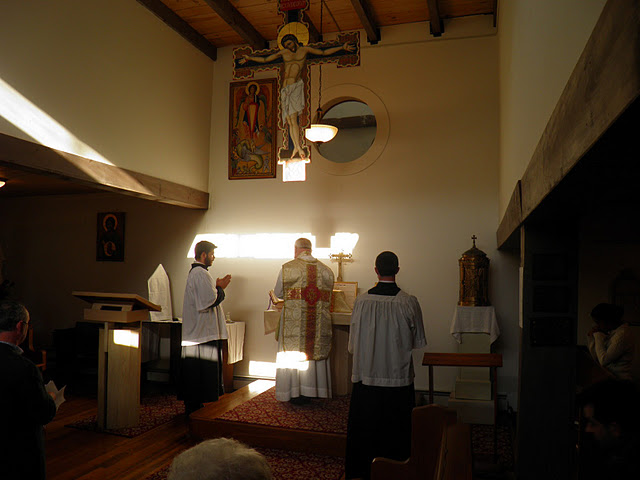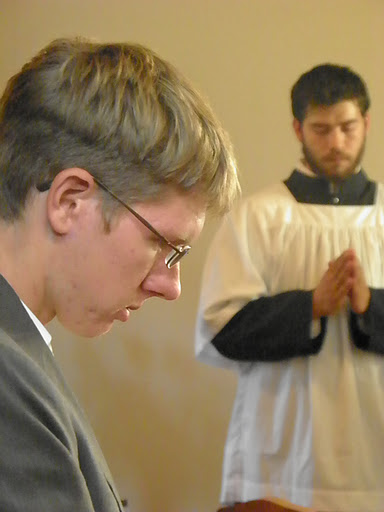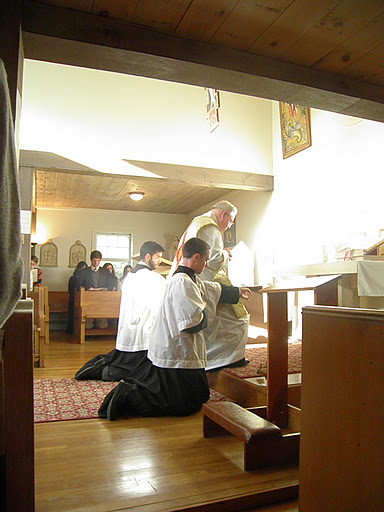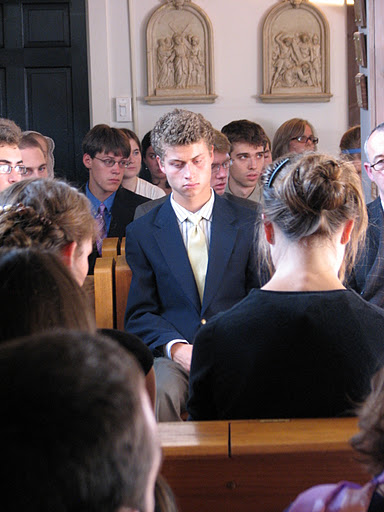 The choir at Thomas More College of Liberal Arts is busy learning a repertoire for the Mass and the Liturgy. The aim is to have a repertoire that is small enough that each piece is heard often enough by those who are not in the choir that they can become familiar and sing along. At the same time it must be large enough that there is some variety in the music.
In regard to the choice of pieces, we have in mind also the principle of noble simplicity. Again this is to facilitate active participation of the laity in the liturgy. Accordingly we try to choose music that that is appropriate, simple and beautiful. We choose predominantly chant and traditional liturgical hymns and polyphony, with the idea in mind that it should be simple enough so that most people can quickly learn to sing it and it is beautiful enought so that they are motivated to do so.
The choir at Thomas More College of Liberal Arts is busy learning a repertoire for the Mass and the Liturgy. The aim is to have a repertoire that is small enough that each piece is heard often enough by those who are not in the choir that they can become familiar and sing along. At the same time it must be large enough that there is some variety in the music.
In regard to the choice of pieces, we have in mind also the principle of noble simplicity. Again this is to facilitate active participation of the laity in the liturgy. Accordingly we try to choose music that that is appropriate, simple and beautiful. We choose predominantly chant and traditional liturgical hymns and polyphony, with the idea in mind that it should be simple enough so that most people can quickly learn to sing it and it is beautiful enought so that they are motivated to do so.
For Latin we choose traditional chant aiming for familiarity with chant Masses for weekdays, Sundays, Marian Feasts and Feastdays and Sundays during Lent and Advent. These are introduced gradually, so that there is a slowly growing core repertoire. We are very lucky to have Dr Tom Larson of the Schuler Singers coming to the college to teach us. He posts audio files of those things that we need to learn so that we can download them. I am now the proud owner of an ipod! So I download these files and sing them as I drive into work every morning. We are a choir learning at the beginning so we are not capable yet of anything beyon simple polyphonic pieces (never mind the rest of the congregation). But for most part, the assumption will be the polyphonic pieces are an invitation to meditation on the part of the congregation. Accordingly the degree of polyphonic content would always be chosen so that the degree of active singing participation is balanced with listenting so as to encourage even on these occasions an engaged contemplation of the liturgy (which is another aspect of active participation in the liturgy of course).
 When seeking to get the music in the liturgy going at the college, especially chant in the liturgy of the hours, I took advice on what might be the best way to do it. A useful piece of advice that was given to me by Fr Frank Philips of St John Cantius in Chicago. He suggested that we pitch the singing down so that it is always comfortable for men to sing. He said that the women will be more able (and more inclined!) to sing lower than the men will be able to sing higher. This was important to me, because I wanted the males students to develop the habit of singing their prayers without being self-conscious about it.
When seeking to get the music in the liturgy going at the college, especially chant in the liturgy of the hours, I took advice on what might be the best way to do it. A useful piece of advice that was given to me by Fr Frank Philips of St John Cantius in Chicago. He suggested that we pitch the singing down so that it is always comfortable for men to sing. He said that the women will be more able (and more inclined!) to sing lower than the men will be able to sing higher. This was important to me, because I wanted the males students to develop the habit of singing their prayers without being self-conscious about it.
The hope in engaging the men in the college is to re-establish the idea that prayer is a masculine thing and so promote the idea that fathers can lead the family in prayer; and perhaps also encourage vocations to the priesthood. The audio files that Tom posts for us are pitched lower than many other chant resources I have come across and so are comfortable for most amateur male voices. This has encouraged a more vigourous masculine sound to the chant. Wherever possible we sing antiphonally, separating men and women. This allows each voice to flourish separately in a complementary rather than a competitive way.
For variation we sing some of the Propers and Latin hymns with an 'organum' - a very simple but beautiful harmony. If you listen to this version of Stabat Mater, you hear occasionally a simple harmony behind the chant. It always strikes me that is mimicking the echo that is there if you sing in a church that is built acoustically for chant, such as a gothic abbey. I am an oblate of Pluscarden Abbey in Scotland, which is a medieval building. When I am there the harmonising echo that resonates, complements the singing and always suggests to me the voices of the angels and saints in the heavenly liturgy which we know, objectively, are singing with us.
http://www.youtube.com/watch?v=muJccdJJrwk
The occasional use of organum opens the imagination of the listeners to the implied harmonies that are present in the intervals of pure chant.
For the vernacular we look to the traditions of harmonised Anglican chant and also Eastern tones. Latin emphasises syllables in a very different way to English. Consequently, plainchant, which was developed over centuries to suit the rhythms and patterns of the Latin language is difficult to adapt to English. The Anglicans had a centuries old tradition of doing this and from it has developed a distinct tradition. I have interpreted Pope Benedict XVI's creation of the Anglican Ordinariate and his attendance at Choral Evensong when he visited last year as a sign that we have been encouraged to look at it as a resource for the vernacular. in the link below you can hear an Anglican adaptation of the Latin tonus peregrinus (which is itself an adaptation of a tone from the pre-Christian Jewish liturgy). While the harmonisation will require a choir, all the students are taught to sing the basic melody and they pick this up very quickly indeed.
http://www.youtube.com/watch?v=9f4_IhaSnVw
Because the Greek and Slavic languages have a punchier rhythms and stresses on the consonants, the music of the Eastern liturgy has, it seems to me, been adapted to English much more successfully. We have been using some of the harmonised tones in our own liturgy too.
http://www.youtube.com/watch?v=WkqZbFQb0O0&feature=related
We have found that when these are rooted in the rhythm of speech and musically are in modal form, it is possible, with careful choice, to have a unified feel to the music of the liturgy while relying on these different sources.
Much of what we do is adapted to make it simple for many to join in. I hope gradually (assuming I can cope with the technology) to start posting examples of our choir singing these adaptations.
Readers may also like to know that the Schuler Singers are singing at the installation of the new Bishop of New Hampshire, Most Reverend Peter A. Libasci on December 8th, 2pm at St Joseph's Cathedral in Manchester, New Hampshire.






